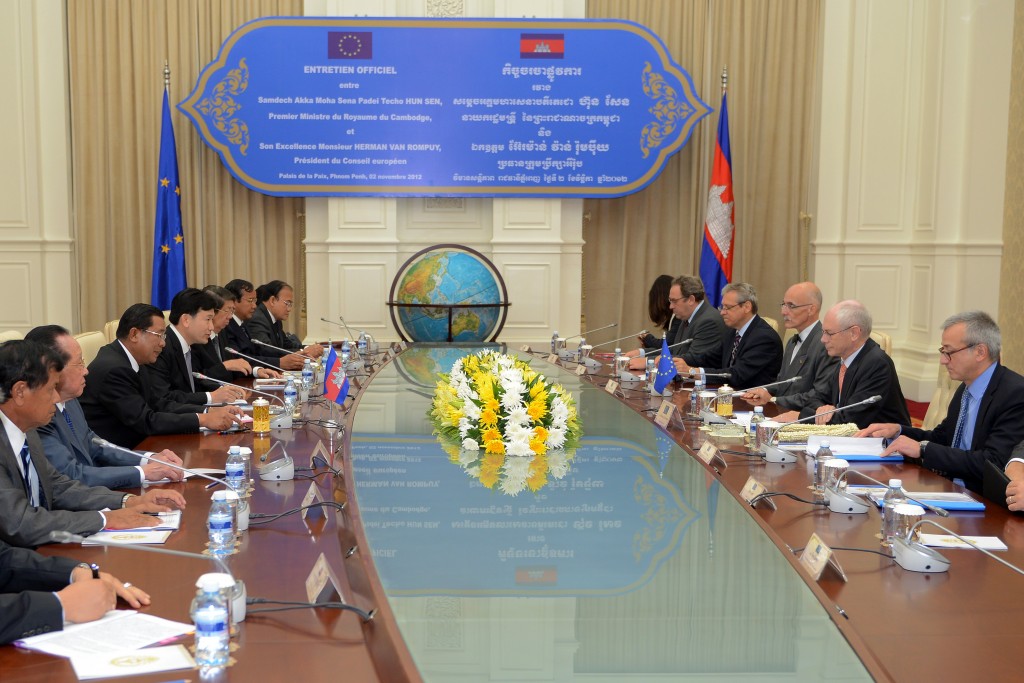
Cambodia’s Prime Minister Hun Sen (3rd L) speaks to President of the European Council Herman Van Rompuy (2nd R), at the Peace Palace, Cambodia. Photo by President of the European Council, taken on November 2 2012. Licensed under CC BY-NC-ND 2.0
In each legislature of parliament, the Royal Government of Cambodia, the executive, is established for a mandate of 5 years through universal and direct elections for the National Assembly. Upon the proposal of the president of the National Assembly and with the agreement of the two vice presidents, the king, as the head of state, nominates a high ranking personality from members from winning political parties to establish a cabinet. After the 2013 national election, the government of the fifth mandate was established.1
The cabinet, ministries and other national bodies may change in composition and number. Royal decrees may make changes to the components of the Council of Ministers as well as leadership within ministries and other national entities. It is not necessary that all of them submit themselves to a vote of confidence by the National Assembly, but where this is done it is only early in their mandates.
Nearly all of the government members are heads of government ministries and national bodies. To maintain the independence of the bodies they serve, some presidents and members of the remaining national bodies are not government members. Those national organs are not part of the executive, legislative and judiciary but independent national institutions.
Nearly all of the ministries were established in 1995. A few ministries were only recently created in the post-2013 national election by a separation of a ministry into two ministries2, or an upgrade of a secretariat into a ministry.3 There are currently 28 government ministries and secretariats, and many national bodies as listed below.
Some national bodies are provided for in the Constitution and others are stipulated in laws. While they are all created by either laws or royal decrees, their organization and functioning is defined by sub-decrees (to see more about the types, hierarchies and legislative process of any legal texts, go directly to law and judiciary).
A reform involving most of the national bodies happened immediately after the 2013 national election. They are no longer under oversight of the Office of the Council of Ministers but each government ministry.4 The reform aimed to reorganize and classify national bodies in charge of each sector into relevant ministries.
Below are the lists of government ministries and national bodies. Each link will provide insights into the jurisdiction and responsibilities of each ministry or national body. A lot of online resources can be found at each ministerial portal page.
Government ministries and secretariats
- Office of the Council of Ministers
- Ministry of Agriculture, Forestry and Fisheries
- Ministry of Civil Service
- Ministry of Commerce
- Ministry of Cult and Religion
- Ministry of Culture and Fine Arts
- Ministry of Economy and Finance
- Ministry of Education, Youth and Sport
- Ministry of Environment
- Ministry of Foreign Affairs and International Cooperation
- Ministry of Health
- Ministry of Industry and Handicrafts
- Ministry of Information
- Ministry of Interior
- Ministry of Justice
- Ministry of Labour and Vocational Training
- Ministry of Land Management, Urban Planning and Construction
- Ministry of Mines and Energy
- Ministry of National Defense
- Ministry of Parliamentary Affairs
- Ministry of Planning
- Ministry of Posts and Telecommunication
- Ministry of Public Works and Transport
- Ministry of Social Affairs, Veterans and Youth Rehabilitation
- Ministry of Tourism
- Ministry of Water Resources and Meteorology
- Ministry of Women’s Affairs
- State Secretariat of Civil Aviation
Some selected national bodies
- National Bank of Cambodia (NBC)
- Council for Development of Cambodia (CDC)
- Supreme National Economic Council (SNEC)
- Constitutional Council (CC)
- National Election Committee (NEC)
- National Institute of Statistics (NIS)
- Tonle Sap Authority (TSBA)
- National Authority for Land Dispute Resolution (NALDR)
- APSARA Authority
- Cambodian Mine Action and Victim Assistance Authority (CMAA)
- National AIDS Authority (NAA)
- National Authority for Combating Drugs
- National Information Communication Technology Development Authority (NiDA)
- Electricity Authority of Cambodia
- Anti-Corruption Unit (ACU)
- Supreme Council of National Defense
- National Supreme Council of Education
Related to ministries and national bodies
Last updated: 29 September 2015
References
- 1. Royal Decree No. NS/RKM/0913/903 dated on September 24, 2013
- 2. Ministry of Industry and Handicrafts by Royal Decree No. NS/RKM/1213/018 dated on December 6, 2013. Ministry of Mines and Energy by Royal Decree No. NS/RKM/1213/017 dated on December 6, 2013.
- 3. Ministry of Public Service by Royal Decree No. NS/RKM/1213/016 dated on December 6, 2013.
- 4. National Committee for Sub-National Democratic Development. “Legal framework: List of royal decrees for integration of national bodies into governmental ministries.” Accessed on September 2, 2015, http://lb.ncdd.gov.kh/Share/Doc%20in%20Library-3/REGULATION/ROYALDECREE/RDE-%20Integration%20of%20instutions%20-2013.pdf

